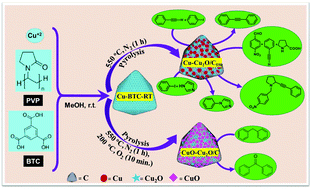当前位置:
X-MOL 学术
›
Inorg. Chem. Front.
›
论文详情
Our official English website, www.x-mol.net, welcomes your
feedback! (Note: you will need to create a separate account there.)
Selective synthesis of Cu–Cu2O/C and CuO–Cu2O/C catalysts for Pd-free C–C, C–N coupling and oxidation reactions†
Inorganic Chemistry Frontiers ( IF 6.1 ) Pub Date : 2019-01-03 00:00:00 , DOI: 10.1039/c8qi01198b
Ashish Kumar Kar 1, 2, 3, 4 , Rajendra Srivastava 1, 2, 3, 4
Inorganic Chemistry Frontiers ( IF 6.1 ) Pub Date : 2019-01-03 00:00:00 , DOI: 10.1039/c8qi01198b
Ashish Kumar Kar 1, 2, 3, 4 , Rajendra Srivastava 1, 2, 3, 4
Affiliation

|
In this study, the preparation of economical Cu-based catalysts for Pd-free coupling and oxidation reactions was demonstrated. For the preparation of the Cu-based catalyst, first, a Cu-BTC MOF was prepared under ambient conditions. The Cu-BTC MOF was then carbonized in N2 to obtain Cu–Cu2O-supported carbon materials. Moreover, the Cu–Cu2O-supported carbon material was subjected to heating in O2 to obtain the CuO–Cu2O-supported carbon material. Formation of Cu-BTC-MOF, Cu–Cu2O, and CuO–Cu2O was confirmed via powder X-ray diffraction (XRD) and X-ray photoelectron spectroscopy (XPS). The amount and types of carbon present in the catalyst were confirmed using thermogravimetric analysis and Raman spectroscopy, respectively. The textural properties of the materials were determined using N2-sorption measurement. The morphology, porosity, and elemental composition were confirmed via the scanning and transmission electron microscopy images. The Cu–Cu2O-supported carbon material successfully catalyzed the Sonogashira cross-coupling (C–C cross-coupling reaction), Ullmann amination (C–N coupling reaction), and A3 coupling (decarboxylative C–C and C–N coupling) reactions; moreover, the CuO–Cu2O-supported carbon material successfully oxidized diphenylmethane in O2 at 1 atm. The catalysts were found to be stable and recyclable. Heterogeneity of the reaction was confirmed via the CS2 poisoning and hot-filtration tests. The presence of the optimum amount and the suitable oxidation state of Cu in the stable nanoporous carbon matrix having graphitic conducting nature were responsible for the excellent activity and recyclability. The results demonstrate that the applications of these Cu-based catalysts can be extended to several catalytic reactions that are known to be catalyzed using Pd and other costly metals.
中文翻译:

用于无钯C–C,C–N偶联和氧化反应 的Cu–Cu 2 O / C和CuO–Cu 2 O / C催化剂的选择性合成†
在这项研究中,证明了用于无Pd偶联和氧化反应的经济型铜基催化剂的制备。为了制备Cu基催化剂,首先,在环境条件下制备Cu-BTC MOF。然后在N 2中将Cu-BTC MOF碳化以获得Cu-Cu 2 O负载的碳材料。此外,将Cu-Cu 2 O担载碳材料在O 2中加热以获得CuO-Cu 2 O担载碳材料。Cu-BTC-MOF,Cu–Cu 2 O和CuO–Cu 2 O的形成通过粉末X射线衍射(XRD)和X射线光电子能谱(XPS)。分别使用热重分析和拉曼光谱法确定催化剂中碳的含量和类型。使用N 2吸收测量来确定材料的质构性质。通过扫描和透射电子显微镜图像确认形态,孔隙率和元素组成。Cu–Cu 2 O负载的碳材料成功催化了Sonogashira交叉偶联(CC交叉偶联反应),Ullmann胺化反应(C–N偶联反应)和A 3偶联(脱羧化C–C和C–N)耦合)反应;此外,CuO–Cu 2O负载的碳材料在1个大气压下成功地氧化了O 2中的二苯甲烷。发现该催化剂是稳定的和可回收的。通过CS 2中毒和热过滤测试确认了反应的异质性。在具有石墨导电性的稳定的纳米多孔碳基体中,最佳量的铜和合适的氧化态的存在是导致优异的活性和可回收性的原因。结果表明,这些基于铜的催化剂的应用可以扩展到已知使用Pd和其他昂贵金属催化的几种催化反应。
更新日期:2019-01-03
中文翻译:

用于无钯C–C,C–N偶联和氧化反应 的Cu–Cu 2 O / C和CuO–Cu 2 O / C催化剂的选择性合成†
在这项研究中,证明了用于无Pd偶联和氧化反应的经济型铜基催化剂的制备。为了制备Cu基催化剂,首先,在环境条件下制备Cu-BTC MOF。然后在N 2中将Cu-BTC MOF碳化以获得Cu-Cu 2 O负载的碳材料。此外,将Cu-Cu 2 O担载碳材料在O 2中加热以获得CuO-Cu 2 O担载碳材料。Cu-BTC-MOF,Cu–Cu 2 O和CuO–Cu 2 O的形成通过粉末X射线衍射(XRD)和X射线光电子能谱(XPS)。分别使用热重分析和拉曼光谱法确定催化剂中碳的含量和类型。使用N 2吸收测量来确定材料的质构性质。通过扫描和透射电子显微镜图像确认形态,孔隙率和元素组成。Cu–Cu 2 O负载的碳材料成功催化了Sonogashira交叉偶联(CC交叉偶联反应),Ullmann胺化反应(C–N偶联反应)和A 3偶联(脱羧化C–C和C–N)耦合)反应;此外,CuO–Cu 2O负载的碳材料在1个大气压下成功地氧化了O 2中的二苯甲烷。发现该催化剂是稳定的和可回收的。通过CS 2中毒和热过滤测试确认了反应的异质性。在具有石墨导电性的稳定的纳米多孔碳基体中,最佳量的铜和合适的氧化态的存在是导致优异的活性和可回收性的原因。结果表明,这些基于铜的催化剂的应用可以扩展到已知使用Pd和其他昂贵金属催化的几种催化反应。

































 京公网安备 11010802027423号
京公网安备 11010802027423号